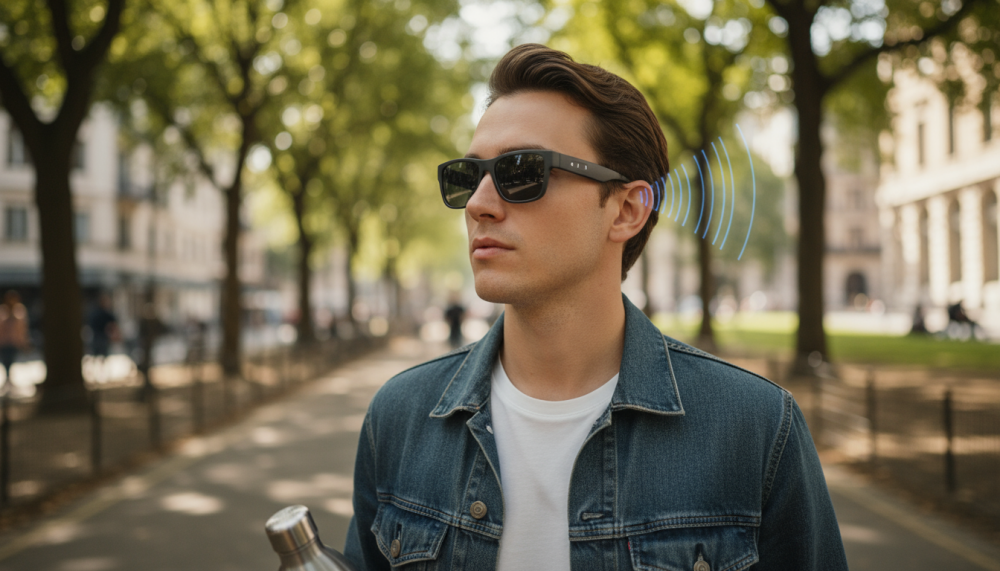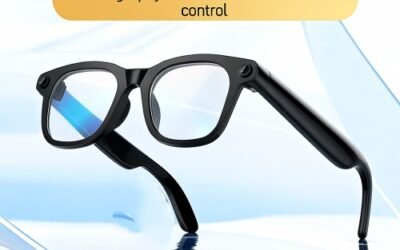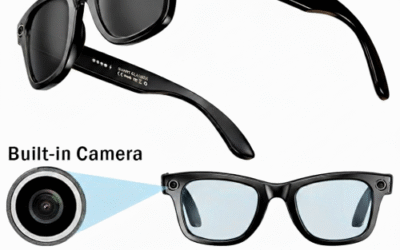Remember juggling your phone, tangled earbud wires, and sunglasses on your last walk? It’s a common frustration. But what if you could combine two essential accessories into one sleek device? Welcome to the world of bluetooth sunglasses. This innovative wearable technology is quickly gaining popularity, offering a seamless way to enjoy music, podcasts, and calls while protecting your eyes from the sun. You no longer have to fumble with tiny earbuds or block out the world around you. Designed for modern life, these glasses blend style with high-tech function. This guide will demystify the technology, compare key features, and help you choose the perfect pair of audio sunglasses for your lifestyle.
What Are Bluetooth Sunglasses and How Do They Work?
At their core, bluetooth sunglasses are exactly what they sound like: sunglasses with wireless audio technology built directly into the frame. Think of them as a personal sound system that you wear on your face. By integrating miniature electronics into the arms of the glasses, they eliminate the need for separate headphones, offering a practical two-in-one solution for anyone on the go.
The magic lies in a few key components working together. First, they use standard Bluetooth technology to pair wirelessly with your smartphone, smartwatch, or any other compatible device, just like regular headphones. This connection allows you to stream audio directly to the glasses. The sound is delivered through tiny, integrated sunglass speakers. Most models use an “open-ear” design, where small speakers are positioned just in front of your ears, directing sound toward your ear canals without covering them. A less common alternative is bone conduction technology, which sends sound vibrations through the bones of your skull to your inner ear. Both methods achieve the same goal: delivering clear audio while leaving your ears open to your surroundings.
The benefits of this design are significant. The most important advantage is situational awareness. Because your ears aren’t plugged, you can still hear traffic while cycling, listen for announcements at a train station, or chat with a friend without pausing your music. This makes them much safer for outdoor activities than traditional earbuds. They also offer incredible convenience; with a built-in microphone, you can take calls or use your phone’s voice assistant (like Siri or Google Assistant) completely hands-free. When you combine this with essential UV protection, you get a single, stylish, and highly functional accessory that simplifies what you need to carry every day.
Key Features to Compare in Audio Bluetooth Sunglasses
When you start shopping for audio bluetooth sunglasses, you’ll find a wide range of models with different features and prices. To make an informed decision, it’s important to know what to look for. Breaking down the key features will help you prioritize what matters most to you.
- Audio Quality: This is arguably the most critical factor. While open-ear speakers won’t deliver the deep bass of over-ear headphones, the best models offer surprisingly clear and rich audio for music and podcasts. Check reviews that mention clarity at different volumes and performance during phone calls. Some models are tuned for vocal clarity, making them ideal for calls and audiobooks, while others aim for a more balanced musical experience.
- Design and Comfort: Since you’ll be wearing these on your face, comfort is non-negotiable. Look for frames made from lightweight yet durable materials like TR-90 nylon. The overall weight, and especially its distribution, determines if they are comfortable for long periods. A pair that feels too heavy or unbalanced on your nose and ears will quickly become a nuisance. Frame style is also a personal choice, with many brands offering classic designs like the Wayfarer or sportier wraparound looks.
- Lens Technology: The “sunglasses” part of the equation is just as important. Always ensure the lenses provide 100% UVA/UVB protection. For superior visual clarity, look for polarized lenses. Polarization is a special filter that dramatically reduces glare from reflective surfaces like water, pavement, and snow, which lessens eye strain and improves safety. Some premium models also offer interchangeable lenses, allowing you to swap them for different light conditions or even clear prescription lenses.
- Battery Life: As electronic devices, these glasses run on a battery. Check the manufacturer’s stated playback time, which usually ranges from 4 to 8 hours on a single charge. Also, consider the standby time—how long the glasses last when connected but not playing audio. Charging methods vary; many use a standard USB-C port, while others have proprietary magnetic cables. USB-C is generally more convenient, as you likely already have these cables for other devices.
- Controls and Connectivity: How you interact with your glasses is important. Most models use a combination of small physical buttons and touch-sensitive panels on the arms. Intuitive controls for playing/pausing music, skipping tracks, adjusting volume, and answering calls are essential. Also, check the Bluetooth version; Bluetooth 5.0 or newer provides a more stable, efficient connection with a longer range.
- Durability and Water Resistance: If you plan to use your sunglasses for sports or outdoor activities, look for an IP (Ingress Protection) rating. An IPX4 rating is common and means the glasses are resistant to sweat and splashes of water from any direction, making them suitable for running or light rain. A higher rating offers more protection, but very few are fully waterproof.
Bluetooth Sunglasses vs. Traditional Smart Glasses: A Clear Comparison
The term “smart glasses” is often used interchangeably with audio sunglasses, but there’s a crucial distinction. While all audio sunglasses are a form of smart glasses, not all smart glasses are focused solely on audio. Understanding this difference will help you avoid paying for features you don’t need.
Your typical bluetooth sunglasses are best described as “audio-first” wearables. Their primary purpose is to combine eye protection with a personal audio experience. They focus on delivering music, podcasts, and calls in a convenient, hands-free package. They are essentially sunglasses that have speakers and a microphone, designed as a straightforward replacement for your headphones when you’re outdoors. Their feature set is focused, their operation is simple, and their price is generally more accessible.
True “smart glasses,” on the other hand, are more like wearable computers for your face. While they almost always include audio, their core purpose is much broader. These devices often incorporate technology like integrated cameras for taking photos and videos (e.g., Ray-Ban Stories) or even augmented reality (AR) displays that overlay digital information onto your view of the world. While these advanced smart glasses may have polarized sunglasses with bluetooth speaker functionality, it is just one part of a more complex system. They are designed for capturing content, navigating with on-screen directions, or interacting with apps in a new way. This added complexity naturally comes with a higher price tag, a steeper learning curve, and potential privacy concerns, especially with camera-equipped models.
So, which is right for you? If your goal is simply to listen to music and take calls safely and conveniently while you’re running, walking the dog, or relaxing by the pool, a pair of dedicated audio bluetooth sunglasses is the perfect choice. They are purpose-built for the job and offer the best value. If you’re a tech enthusiast who wants to be on the cutting edge, capture first-person video, or experiment with augmented reality, then the broader category of smart glasses is where you should be looking.
Finding the Perfect Pair: Sunglasses That Have Speakers for Every Lifestyle
The best pair of sound glasses bluetooth sunglasses is the one that fits seamlessly into your daily routine. By thinking about how you’ll use them most, you can zero in on the features that matter. Let’s break down the ideal choices for different lifestyles.
- For Sports & Outdoors: Athletes and adventurers should prioritize a secure, snug fit that won’t slip during intense activity. Look for wraparound styles or frames with rubberized nose pads and temple tips for extra grip. Durability and a high water-resistance rating (IPX5 or higher, if possible) are crucial to withstand sweat and unexpected weather. Lightweight construction is also key to ensure comfort during long runs or bike rides.
- For Daily Commuting: If you’re navigating busy city streets, situational awareness is your top priority. The open-ear design is perfect for this. You should also focus on microphone quality. A good noise-canceling microphone system will ensure your voice is heard clearly on calls, even with background traffic noise. Battery life is another important consideration to make sure your glasses last for your entire round-trip commute.
- For Fashion & Casual Use: For those who prioritize aesthetics, the design is paramount. Many brands now offer sunglasses that have speakers in timeless, fashionable frame shapes that don’t scream “tech gadget.” Look for discreetly integrated controls and a variety of color options. Here, audio quality for music might be more important than call clarity, so look for models praised for their balanced sound.
- For Travel: A great travel companion needs to be long-lasting and convenient. Prioritize models with long battery life and a protective, compact carrying case. A standard USB-C charging port is a huge plus, as it means one less proprietary cable to pack. If your travels take you to diverse locations, a pair with easily interchangeable lenses can be incredibly versatile.
To give you a balanced view, here are the general pros and cons of this technology:
Pros:
- Unmatched Convenience: One device for audio and sun protection.
- Enhanced Safety: Open-ear design keeps you aware of your surroundings.
- Hands-Free Operation: Take calls and use voice assistants without touching your phone.
- Style Integration: Tech that complements your personal style rather than clashing with it.
Cons:
- Sound Leakage: At high volumes, people nearby may hear your audio.
- Battery Dependency: Another device to remember to charge.
- Potential Bulk: Can be slightly heavier and thicker than standard sunglasses.
- Price: Generally more expensive than a non-tech pair of sunglasses.
Before you buy, always check the brand’s reputation, warranty, and return policy to ensure a risk-free purchase.
Frequently Asked Questions About Sound Glasses
As with any new technology, it’s normal to have questions. Here are concise answers to some of the most common queries about sound glasses bluetooth sunglasses.
Q: Are bluetooth sunglasses safe for my ears?
A: Yes, they are generally considered very safe. The open-ear design directs sound toward your ears without sealing the ear canal, which avoids the pressure buildup and potential for ear infections associated with some in-ear headphones. As with any audio device, it’s always wise to listen at a moderate volume to protect your long-term hearing.
Q: How do I connect my audio sunglasses to my phone?
A: The process is the same as pairing any other Bluetooth device. First, turn on the sunglasses and put them into pairing mode (usually by pressing and holding a button). Then, open the Bluetooth settings on your smartphone, find the sunglasses in the list of available devices, and tap to connect. They will typically auto-connect on subsequent uses.
Q: Can I make phone calls with these sunglasses?
A: Absolutely. Nearly all models come with one or more built-in microphones for this purpose. This allows you to answer, reject, and make calls completely hands-free. The call quality will depend on the microphone system in the specific model you choose.
Q: Are they waterproof or just water-resistant?
A: Most audio sunglasses are water-resistant, not waterproof. They typically have an IPX4 rating, which means they can handle sweat and light splashes of rain. However, they should not be submerged in water, so don’t wear them while swimming.
Q: Do they leak sound to others nearby?
A: There can be some sound leakage, especially at higher volumes. In a quiet environment like an office or library, someone sitting close to you might be able to hear faint audio. However, in most outdoor or moderately noisy settings, the leakage is generally unnoticeable to others.
Q: How do I clean and maintain my smart audio glasses?
A: Treat the lenses as you would any pair of quality sunglasses: use the provided microfiber cloth to wipe away smudges. For the frame, you can use a slightly damp cloth, but be careful to avoid getting moisture into any charging ports or speaker grilles. Always store them in their protective case when not in use.
Q: What’s the typical battery life I can expect?
A: On average, you can expect between 4 to 8 hours of continuous music playback on a full charge. This can vary depending on the model, your listening volume, and whether you are also using them for phone calls. Standby time is usually much longer, often lasting for a day or more.
Making Your Choice: Final Verdict and Recommendations
Stepping into the world of audio eyewear is an exciting upgrade from traditional sunglasses and headphones. The best bluetooth sunglasses are more than just a novelty; they are a genuinely practical tool for modern life, offering a unique blend of safety, convenience, and style. The core of this technology is its open-ear audio design, which delivers your personal soundtrack without isolating you from the world. It’s also important to distinguish them from more complex and expensive smart glasses to ensure you get a device that truly meets your needs.
As you prepare to choose, let your lifestyle be your guide. The key is to find the perfect balance of features that matter most to you. Are you an athlete? Prioritize a secure fit, durable build, and high water-resistance rating. Are you a daily commuter or remote worker who takes lots of calls on the go? A model with a superior noise-canceling microphone and long battery life should be at the top of your list. Or perhaps you’re a style-conscious person looking for a chic accessory that also plays music. In that case, focus on frame design, brand reputation, and overall aesthetic.
Don’t forget the fundamentals: excellent UV protection and polarized lenses are non-negotiable for protecting your vision and enhancing clarity. Ultimately, the right pair of audio sunglasses will feel like a natural extension of yourself—a device you put on without a second thought. They simplify your gear, keep you safe, and let you enjoy your world with a personalized soundtrack. Armed with this knowledge, you’re ready to explore the exciting options available and find the perfect pair to change the way you see and hear the world.




0 Comments